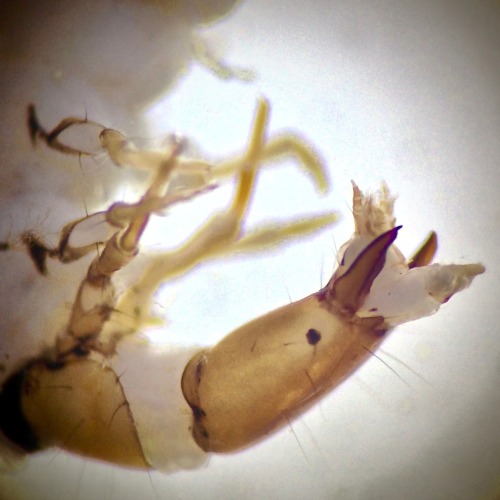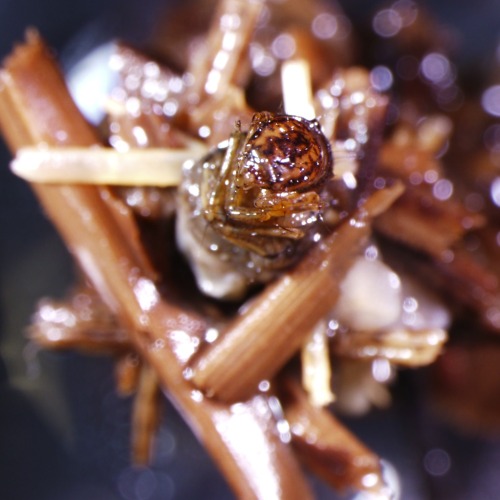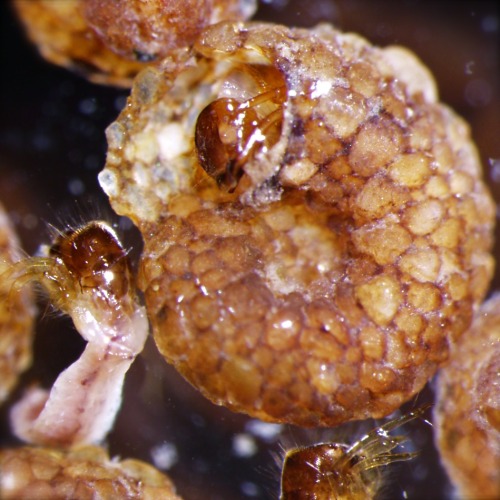#trichoptera
The top picture is a case made by a caddisfly in the genus Platycentropus. The larvae stack small, short pieces of detritus at varying angles to build a short, bulky home. The bottom picture is the Platycentropus in its case.
Order: Trichoptera
Family: Limnephilidae
Genus: Platycentropus
Oswego County, NY
Post link
One last shot of this cool little guy. (Trichoptera, Helicopsychidae, Helicopsyche). Pratt’s Falls, NY
Helicopsychidae are clingers, with the larvae living in the portable cases pictured above. Because of how similar their cases look to snail shells, this family was actually originally described as a snail. The helical shape of the case improves resistance to crushing (Voshell, JR. 2002).
Post link
A group of Helicopsyche, collected from Pratt’s Falls, NY. (Trichoptera, Helicopsychidae, Helicopsyche)
Helicopsychidae are clingers, with the larvae living in the portable cases pictured above. Because of how similar their cases look to snail shells, this family was actually originally described as a snail. The helical shape of the case improves resistance to crushing (Voshell, JR. 2002).
Post link
One of my favorite caddisflies. These little guys make spiral-shaped mobile homes. From Pratt’s Fall, near Syracuse, NY. (Trichoptera, Helicopsychidae, Helicopsyche)
Helicopsychidae are clingers, with the larvae living in the portable cases pictured above. Because of how similar their cases look to snail shells, this family was actually originally described as a snail. The helical shape of the case improves resistance to crushing (Voshell, JR. 2002).
Post link
These Rhyacophila look frozen in time. Really they’re not frozen at all. They’re just really sleepy from a nice cool ethanol bath. So so sleepy. (Order: Trichoptera, Family: Rhyacophilidae)
This particular family of Trichoptera are free-living, unlike the vast majority of caddisflies which build homes/cases to live in.
Free-living caddisflies from the family Rhyacophilidae are typically found in fast-moving mountain streams. These were collected in a short, but fast stream connecting two lakes in the Adirondack preserve. They crawl around underneath rocks, using silk to anchor them to the substrate.
Post link
Black Dancer Caddisfly - Mystacides sepulchralis
The year 2021 was a great year for finding and observing Caddisflies in their natural environment: on the vegetation by nearby streams. Since they’ve pupated, grown their tent-shaped wings and left the flowing water, they aren’t likely to return for a swim anytime soon, and yet they always seem to want to stay nearby. The only time they may actively revisit the water (up close) is to lay eggs. I’m not quite sure what this specie does since there’s not very much information to draw from, but the consensus seems to be that most species don’t lay eggs directly in water. Instead, they are laid in large number on nearby aquatic plants, sometimes coated in a viscous clump of gel. I’ll be looking around the water’s edge this summer for specks or jelly if I find any adults in the area. While I’ve implied that most lay eggs of vegetation, there are reports of some brave Caddisflies diving in to place their eggs! It would save a bit of time and may even be safer for the young larvae, as the ones on the leaves have a bit of exposure to predators and risk of desiccation until they drop into the stream to begin their lives. Gotta gather those stones!
While I’m not sure at all on the egg-laying habits (or dietary habits for that matter) for this specie, I can certainly be sure on the identity of this particular Trichopteran. The Black Dancer Caddisfly has elongated mouthparts (which resemble thick antennae or claws)and a thin, long, whip-like antennae with a ringed pattern along the first few segments. No camera flash was using to grab these pictures, so those red eyes aren’t a consequence of camera light. The eyes can be another trick to help identify these elusive creatures. I’ve read that only the males have bright red eyes, but I couldn’t say for certain. I’d need to do more research, and they only other way to tell for sure would be to examine a specimen with a dissection microscope (which I don’t have). If you do come across an insect that looks like this, monitor it closely, and if you do, document what plants or flowers it prefers to visit. Flowers in particular would be helpful to learn if it actually has a liquid diet or doesn’t feed. With luck, it would be some nearby flowers close to the stream. Depending on the flowers they prefer, those palps might be useful grasp on other structures while feeding or to pull flowers closer to its mouth since Trichopterans lack a proboscis. More info would go a long way here. If a revision to the Audubon Insect Guide comes out, this specie would be a great inclusion for the field guide. Especially since there aren’t many Trichopterans in the guide as is. They’ve been compiled together with similar looking insects (though different orders) such as Lacewings, Alderflies and Stoneflies. The Black Alderfly does have a resemblance to it, but you can tell by looking at wings just how different they are.
Pictures were taken June 16, 2021 with a Google Pixel 4.
Post link

















